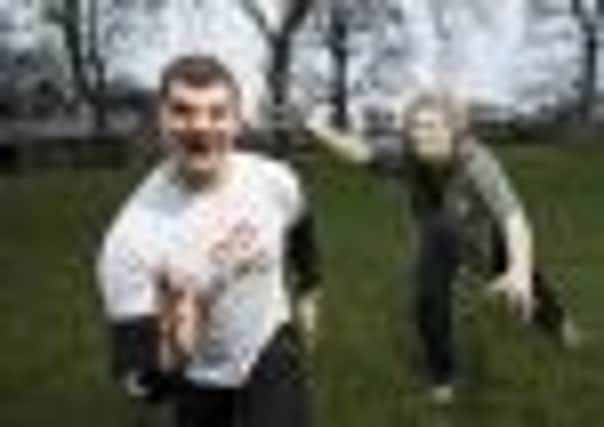Zombie fitness class sees runners chased by the living dead


A local fitness guru is giving horror film fans the chance to live their nightmares and pit their muscles against ravenous chasing zombies – all in the name of exercise.
Former Scotland under-21 rugby player Ian Dryburgh has launched Zombie Survival Club – a series of weekly classes designed to appeal to the inner geek in those wanting to shed weight and get fit across the Capital.
Advertisement
Hide AdAdvertisement
Hide AdParticipants are let loose in Inverleith Park each Wednesday and set a series of physical challenges akin to surviving a zombie apocalypse from classic films such as Dawn of the Dead.


Students are paired up in one of the more basic exercises, with one person designated as the “zombie” and asked to chase the other. They progressively move on to more challenging scenarios – including one in which they are asked to re-enact a boxing session with one of the living dead.
Mr Dryburgh said the emphasis was placed on the skills and fitness needed to survive an imagined zombie attack. The accredited strength and conditioning coach said students tended to be that bit more desperate if they were being hunted – like in the movies.
He said: “If someone is being chased through the park by a zombie, even just a pretend one, they tend to run that bit faster or box that bit more powerfully.
“You don’t need to dress up. You use your imagination for inspiration and your body to win the challenges set out.
“If you get a person in the right mindset, it gets the adrenalin pumping. People will get out of breath because they want to win the challenges and they want to be able to beat their friend, who’s a zombie in this instance.
“The thing that comes back more often than anything else is that people feel like when they were a kid again and they just ran around because it was fun.”
Other scenarios involve people wearing tags meant to represent their “life source” and having to keep the devices while being chased in enclosed spaces.
Advertisement
Hide AdAdvertisement
Hide AdMr Dryburgh said he was not a zombie enthusiast, but had instead thought up the concept during summer last year after speaking to a former student.
A ten-week series of classes was launched in the lead-up to Christmas, with participants ranging in age from 18 to 37.
Mr Dryburgh said their popularity had been such that he was looking to expand the number of sessions. He said: “A lot of people remember physical education at school. They didn’t like playing sports and they don’t like the idea of going on the treadmill and going through the basic routine and getting bored with it.
“Initially it was for gamers and zombie-lovers, something for them, because often there’s no outlet for people like that for actually doing exercise.
“But it turns out after starting it up that everyone actually likes the idea. It’s something different and it’s something actual sports people are using for fitness just because it’s enjoyable.”
Gamification – the concept of using game thinking and mechanics in non-game contexts – is a growing trend across Britain.
Glasgow is one of five UK cities that now host 2.8 Hours Later – a large-scale treasure hunt and chase game in which players hit the streets and have to outrun people made up as zombies as they hunt for clues to the whereabouts of a survivors’ camp.
n Zombie Survival Camp runs at Inverleith Park each Wednesday from 6pm. More information is available on 07576 624 805.
Alternative fitness
Advertisement
Hide AdAdvertisement
Hide Ad• Zumba: a Colombian dance fitness program created by choreographer Alberto “Beto” Perez during the 1990s. Routines incorporate dance and aerobic elements. Zumba uses hip-hop, samba, salsa, mambo, martial arts and some Bollywood and belly dancing moves.
• Pole dancing: previously confined to strip clubs, pole dancing surged in popularity during the mid- 2000s. It involves using a vertical pole to perform dancing and acrobatic tricks as a means of getting fit.
• Cheerleading: films such as Bring It On helped elevate cheerleading to competitive sport status and as a fitness exercise. It is based on organised routines, usually performed in one to three minutes, that involve tumbling, dance, jumps, cheers and other stunts.
• Hula hooping: once viewed as a kids’ toy, the hula hoop has become a fitness tool, with classes springing up around Britain. Hooping targets the waist and stomach muscles. Some courses have claimed members who hula hoop two hours every week for six weeks will lose three inches off their waists.
• FitWet: the trendy exercise machine was launched last year and involves riding a stationary bike while sitting in a hot tub.